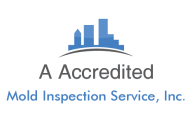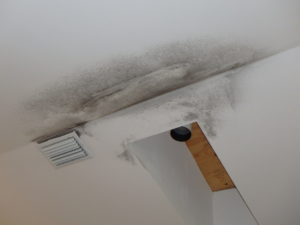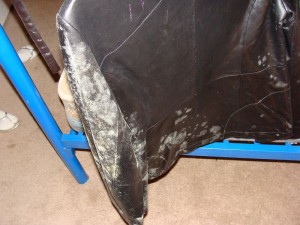Indoor Humidity Levels
People often ask us at A Accredited Mold Inspection Service “what are normal indoor humidity levels?” or “what should the humidity level in my home be?”
Below is an article on the topic from our mold inspection company. So keep reading to learn about what normal humidity levels should be in your home.
We have provided mold testing and humidity problem consultation in Florida since 2003. For our mold inspection and humidity testing services click here.
For our humidity control tips page click here.
What Are Normal Indoor Humidity Levels
Some reputable sources say acceptable indoor humidity levels should be below 60%RH, and others say they should be below 65%RH, others say 50%RH or lower.
Why the discrepancy? What is the ideal humidity level.
Where are these recommendations coming from?
What is the right answer?
Some Sources Recommend Levels Below 65%RH
Older ASHRAE Recommendation
A humidistat is a device that communicates humidity readings to your AC so your AC can control the amount of humidity in your air. For homes with humidistats it is common to see “keep humidistat set below 65%RH” written on the humidistat. It seems this must be correct if it is written on your humidistat.
Where does this suggestion on your humidistat originate? It comes from the American Society of Heating Refrigeration and Air Conditioning Engineers (ASHRAE).
However, this setting of below 65%RH is an older recommendation and is for human comfort only. It was written before mold was in the public eye as a common health problem and it is not intended to stop mold growth.
So, this setting might be comfortable, but it is a little higher than what we would recommend for a healthy indoor environment from a condensation, mold control, or dust mite control, standpoint.
Most Sources Recommend Home Humidity Levels Below 60%RH.
In our opinion indoor humidity levels below 60%RH is a good goal to aim for. It can help prevent indoor humidity related mold growth, but it also can help lower your chances of dust mite problems. At the same time, it cost less money than trying to maintain a lower setting of 50%RH. It seems to be a good balance between mold control, dust mite control, comfort, and lower AC operational costs.
60% RH is a good goal to maintain. Don’t just take my word for it, here it what others have to say.
U.S. E.P.A. (Environmental Protection Agency)
Keep indoor humidity low. If possible, keep indoor humidity below 60 percent (ideally between 30 and 50 percent) relative humidity. Relative humidity can be measured with a moisture or humidity meter.
Well Known AC Manufacturer (Carrier)
Your home comfort system should provide both comfortable temperatures and comfortable humidity levels. It should maintain your home at the recommended levels of 40-60% relative humidity, preventing growth of mold and mildew and minimizing dust-mites, bacteria and viruses.
Well Known AC Manufacturer (Trane)
Most designers choose a dry-bulb temperature of 72°F to 76°F as the set point. To discourage microbial growth, ASHRAE Standard 62-1999 recommends a relative humidity of 60 percent or less during cooling. Therefore, select the dedicated AC unit to limit the relative humidity in all spaces to no more than 60 percent. Designing a dedicated ventilation system that limits the space relative humidity to a lower value (50 percent, for example) adds unnecessary cost because it requires larger equipment and increases energy consumption.
Some Sources Recommend Levels Below 50% RH
What about maintaining levels below 50%RH?
Though not always needed, this level is beneficial because it makes dust mite growth in your homes dust reservoirs and mattresses and pillows less likely. Levels of below 50% RH can actually kill dust mites after a few weeks. To maintain normal humidity levels in the home turn your AC down a few degrees. The only drawback is that because lower humidity requires turning your AC down, it cost a little more to maintain 50% levels than it does to maintain 60% levels. If you live in Florida then it may be difficult to keep levels this low all the time. If you live in most parts of the United States, then 50%RH should be easy to maintain and an accetable goal.
Below is more information on the 50%RH level guidelines.
Humidifyerinformation.com
Humidifyerinformation.com is a humidifier & dehumidifier sales and information website. The optimum relative humidity level is generally considered to be between 40% and 50%. Levels anywhere between 30% and 60% is acceptable, however, below 50% is recommended to help control dust mites which are bad for allergy sufferers. http://www.humidifierinformation.com/optimum-humidity-levels.php
American Academy of Allergy Asthma & Immunology
To reduce dust mites, it is important to keep humidity below 50% throughout the home by using a dehumidifier or central or window air conditioning.
A Accredited Mold Inspection Service
My openion as a mold inspector and humidity consultant in South Florida, anything below 60% RH is desirable. this level should deter humidity induced mold growth. It may be difficult to keep it any lower than this year around. In addition, as long as your house is not excessivly dusty, you should not have to worry about humidity induced dust mites.
For our humidity control tips page click here.
Here is what can happen if your houses humidity is too high.
All these photos are from actual inspections we conducted.
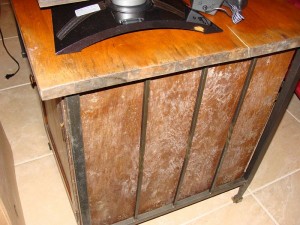
In the total absence of any leaks mold is caused by humidity problems. The white material on the desk is humidity related Pen Asp mold.
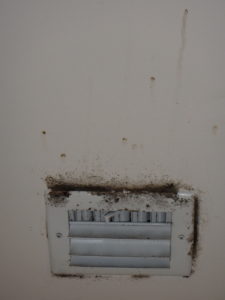
Cladosporium mold on an AC register. This occurs when warm humid air touches cold surfaces and causes condensation. The condensation provides water for mold.
In Conclusion
In conclusion, it is best to maintain humidity levels below 60%RH. This will help control mold and to some extend will help deter dust mite growth.
Alternatively, you can shoot for levels below 50% RH to combat mold growth indoors, and to kill dust mites. In most states this will be easy, but not in Florida. This lower setting is at a higher cost in Florida due to running your AC more to maintain such levels.
In dryer climates you will want to use a humidifier to raise humidity above 35%RH. Try not to raise it above 60%RH for an extended period of time.
Indoor humidity levels and mold growth are a problem that our firm is familiar with. If you need help with Indoor humidity problems and mold growth give us a call and schedule an inspection.
1 (888) 381-665
